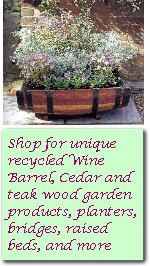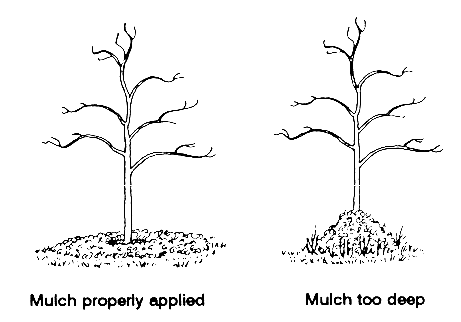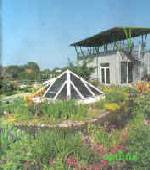|


Related Topics

| |
For as long as trees have grown in forests, leaves and needles have fallen to
the ground and formed a natural protective layer over the soil. This same
protection can be given to the plants in our landscapes by mulching. Mulching
can make a big difference in the success of your landscape. Mulches conserve
soil moisture, allowing you to water less often; keep down weeds; reduce
erosion; keep plant roots cool; provide winter protection; and make your yard
more attractive.
Mulches also simplify lawn mowing around trees and shrubs. A ring of mulch
allows you to bring your lawn mower right up to the edge of the mulch,
eliminating the need for string weeders. At the same time you are protecting
tree trunks and surface roots from damage by mowing and clipping equipment.
Return to Table of Contents
Many materials can be used for mulching. How do you decide which mulch is best
for you? All mulches have different characteristics, some of which may be
advantages in some situations and disadvantages in others. See the list of
mulches in this brochure for information on individual mulches. Before choosing
a mulch, however, consider how you will use it.
-
Summer mulches. Summer mulches are in place during the growing
season and are used primarily for flowers and vegetables. Their roles are to
retain moisture, reduce weed growth, and moderate soil temperatures. Summer
mulches are often left in place through the winter to reduce erosion. For
perennial plants, they can also be supplemented by winter mulches.
-
Permanent mulches. Permanent mulches are used where mulch is
desired year round and does not need to be disturbed—for example, in paths
and around trees and shrubs. If organic material is used,
"permanent" mulches will still need to be replenished annually.
Return to Table of Contents
Summer mulches for annual flowers and vegetable gardens are normally applied in
midspring, once the soil has warmed enough for active root growth. For best weed
suppression in a perennial border, apply mulch in early spring, before the
forsythia blooms. For best results, remove any existing weeds before applying
mulch. Mulches applied for winter protection should be laid down in early
winter, once the soil has cooled but before it has frozen.
For trees and shrubs, spread mulch evenly to a depth of 2 to 3 inches. For
trees and shrubs in beds, mulch the entire bed. For those in a lawn, mulch a
wide ring (extending from 3 to 6 feet out from the trunk) around each plant.
Never pile mulch against tree trunks. Pull mulch back away from the trunk about
an inch or so. As organic mulches decompose, they may need to be replenished
somewhat every year; but don't let mulch build up to depths greater than about 4
inches.

For flower beds, mulch can be applied up to 3 inches deep (after settling),
but should be kept pulled back slightly from plant stems. Mulches should
thoroughly cover an area to a uniform depth to be most effective. Low or bare
spots are prone to weed problems.
Return to Table of Contents
Mulches made from plant material are organic mulches. Over time, organic mulches
will decompose and become part of the soil. This is a great advantage, because
this decomposition adds organic matter to your soil, helping the soil to better
retain water and nutrients-giving you healthier plants. This means, however,
that organic mulches will have to be replenished from time to time.
-
Bark. Bark mulches are usually made from the byproducts of pine,
cypress, or hardwood logs. Most common are shredded bark and bark chunks.
Bark mulches resist compaction, will not blow away, are very attractive, and
are readily available. Some shredded barks, such as cypress, decompose
slowly. Bark chunks (also called nuggets or decorative bark) decompose most
slowly but do tend to wash away.
-
Wood chips. Wood chips are made from many different kinds of trees.
Wood chips make an excellent mulch that resists compaction, stays put, and
weathers to an attractive silvery-gray color. In addition, they are often
available from municipalities or utility companies for little or no cost.
However, such "bargain" mulches are likely to contain seeds from
trees and other plants that can sprout and create weed problems. Also beware
of such mulches that have not been properly aged or composted. Mulch that
has not been aged can be toxic to plants due to the formation of organic
acids during the decomposition process, and, if placed too close to tender
stems, will harm or kill plants. Purchasing mulch from a reputable dealer
who has monitored the decomposition process to achieve a high quality, aged
product will do a lot to ensure that your valuable plants will not be
harmed.
-
Sawdust. Sawdust is often readily available and may be helpful in
acidifying the soil around rhododendrons and other acid-loving plants.
Sawdust is a poor choice in most situations, however, as weed seeds easily
sprout in the mulch. It also tends to cake, making it harder for water to
soak into the ground. Sawdust is low in nitrogen, so it robs nitrogen from
the soil as it decomposes. Therefore, more nitrogen fertilizer may be
needed. A 3- to 6-inch layer of sawdust does work well, however, for
mulching pathways.
-
Straw. Straw makes a good winter mulch or mulch for the vegetable
garden. It is inexpensive, suppresses weeds, conserves moisture, and
insulates well. On the other hand, it is not very attractive, may contain
crop seeds, and is extremely flammable. It is important to purchase
"straw" rather than "hay," as hay contains many weed
seeds. Mulch 6 to 8 inches deep.
-
Pine straw. Pine needles are attractive, decompose slowly, resist
compaction, and are easy to work with. They are often available commercially
or are free if you have pine trees on your property.
-
Shredded Leaves. Leaves that have been shredded with a composting
mower are sometimes used as a summer mulch, although they decompose very
quickly. Whole leaves can be used instead, but they tend to mat together and
block water movement into the soil.
-
Newspaper. Three layers of newspaper can effectively keep down
weeds, especially in the vegetable garden. To keep the paper from blowing
away, weight it down using another mulch or other means. Shredded newspaper
also works well.
Return to Table of Contents
Inorganic mulches, often of stone or plastics, tend to stay in place, do not rob
the soil of nitrogen, and do not harbor weed seeds. However, they have numerous
disadvantages when used in the garden. Stone mulches can migrate down into the
soil in time, making future digging difficult. Light-colored stones can reflect
heat onto plants, scorching sensitive plants. Stones also tend to work free of
beds and can be thrown by lawn mowers, potentially causing injury. Perhaps the
greatest disadvantage, however, is that these mulches do not contribute organic
matter to your soil.
-
Crushed stone, gravel, volcanic rock. These mulches are available
in a wide variety of textures, colors, and materials and are used in rock
gardens, driveways, and walkways. Think carefully and make sure you really
want this type of mulch before putting it in place, because these mulches
are more or less permanent. It is best to underlay these mulches with
landscape fabric to reduce movement of stones into the soil. Once gravel
becomes mixed with the soil, it is nearly impossible to get it out. Many
gravel and stone mulches are made from limestone and cannot be used around
rhododendrons, mountain laurels, and other acid-loving plants. When leaves,
twigs, and other debris fall into coarse rock mulches, they are difficult to
remove and can make the mulch considerably less attractive.
-
Plastics. Plastic works well for keeping weeds down and retaining
soil moisture. Although it prevents water from leaving the soil, it also
prevents it from entering the soil—making it unsuitable for landscape
plantings that depend on rainfall for their water. Plastic is best reserved
for vegetable gardens where irrigation systems can be placed under the
plastic and bare spaces left between rows to allow water entry into the
soil.
-
Geotextiles. These are fabric mulches of polypropylene or
polyester. They work much as plastic does, but allow water and fertilizer to
enter the soil. For the best weed suppression, choose closely woven
geotextiles. Generally the fabric is placed on weed-free ground and covered
with another mulch, such as wood chips, to improve its appearance, keep it
in place, and reduce damage to the fabric by the sun's rays. With these
mulches, it is important to remove weeds as soon as they are noticed.
Otherwise, roots can grow right through the fabric and become very difficult
to pull.
Return to Table of Contents
|
![]() Gardeners' Corner
Kids'
Garden
Sustainable Garden
Contact Us
Gardeners' Corner
Kids'
Garden
Sustainable Garden
Contact Us![]()



